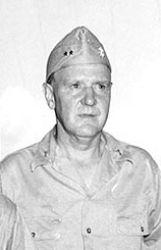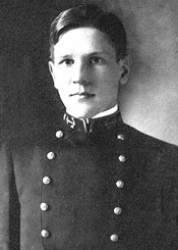
 |
|
|
||
|
Theodore Stark Wilkinson 'Ping' |
||||
|
Graduate, U.S. Naval Academy, Class of 1909 Engagements: • Occupation of Veracruz (1914)• World War I (1914 - 1918)• World War II (1941 - 1945) |
||||
| Biography: | ||||
|
Theodore Stark Wilkinson Vice Admiral, U.S. Navy Medal of Honor Recipient Occupation of Veracruz Vice Admiral Theodore Stark "Ping" Wilkinson was a U.S. Navy officer who received the U.S. military's highest award for valor, the Medal of Honor, for his heroic actions during the Occupation of Veracruz. He also served in World Wars I and II. The Early Years Theodore Stark Wilkinson was born on 22 December 1888 at Annapolis, MD. He entered the U.S. Naval Academy in 1905 and graduated first in the class of 1909. He served the two years of sea duty then required by law prior to commissioning, in the battleships USS Kansas (BB-21) and USS South Carolina (BB-26), before he received his Ensign's commission on 5 June 1911. After instruction at George Washington University in Washington, DC, under the auspices of the Navy's Bureau of Ordnance (BuOrd), Wilkinson reported to the battleship USS Florida (BB-30) on 25 July 1913 for sea duty. During his time in that dreadnought, Ensign Wilkinson led Florida's 2d Company in action during the landings on 21 and April 22, 1914 at Veracruz, Mexico. For his actions he received the Medal of Honor. Medal of Honor Rank and organization: Ensign, U.S. Navy Citation: For distinguished conduct in battle, engagements of Vera Cruz, 21 and 22 April 1914. Ens. Wilkinson was in both days' fighting at the head of his company and was eminent and conspicuous in his conduct, leading his men with skill and courage. World War I and Inter-War Years On 4 August, he was transferred to the armored cruiser USS Tennessee (ACR-10), and two days later sailed eastward in her across the Atlantic. Tennessee and USS North Carolina (ACR-12) were ordered to European waters to evacuate Americans trapped on the continent by the outbreak of World War I. On 3 September, he became an assistant to the naval attaché at Paris and a month later left that post to join North Carolina in the Mediterranean. Subsequently, the young officer had tours of sea duty: first as aide to Commander, 2d Division, Atlantic Fleet, and then as aide to the commander of the 7th Division. From July 1916 to July 1919, Wilkinson served with distinction as the head of the Experimental Section, Bureau of Ordnance, where he developed ordnance materials and devices, most notable being a noxious gas filler for shells and an "exceptionally satisfactory smoke screen." Also, he was deemed largely responsible for the successful design of a depth charge and for the development of the firing mechanism of the Mark VI mine used in the North Sea Mine Barrage. Following that tour ashore-for which he received a letter of commendation-Wilkinson went to sea, first serving as gunnery officer in the battleship Kansas and later as fire control officer in USS Pennsylvania (BB-38). In 1921 and 1922, Wilkinson commanded, in succession, the destroyers USS Osborne (DD-295), USS Goff (DD-247), and USS Taylor (DD-94), before he returned to BuOrd's experimental section. After commanding the destroyer USS King (DD-242) from January 1925 to December 1926, Wilkinson headed the Records Section of the Bureau of Navigation (BuNav) Officer Personnel Division. In June 1930, he became fleet gunnery officer and aide to Commander, Scouting Fleet (later, Commander, Scouting Force), Rear Admiral A. L. Willard. Detached from that duty in December 1931, he soon assumed the duties of secretary to the Navy's General Board. While in that assignment, Wilkinson had additional duty during the arms limitation talks at Geneva in 1933 and in London in 1934. From September 1934 to June 1936, Wilkinson served as executive officer of USS Indianapolis (CA-35). Over the next three years, he headed the Planning Division of BuNav and then returned to Indianapolis, this time in a staff capacity, as Chief of Staff to Commander, Scouting Force. In January 1941, he fleeted up to command the battleship USS Mississippi (BB-41). World War II Detached from that duty and promoted to Rear Admiral, Wilkinson was assigned as Director of the Office of Naval Intelligence (ONI) on 15 October. His new responsibilities inevitably embroiled him in the subsequent controversy over whether the U.S. Pacific Fleet Commander at Pearl Harbor was sufficiently warned of the danger of a Japanese attack before 7 December - an issue on which Wilkinson testified for three days before a joint congressional committee in December 1945. According to his testimony and that of others, ONI was responsible for collecting and evaluating intelligence, but R. Adm. Richmond Kelly Turner, Director of War Plans, had sought and received the authority in 1940 to control information sent to the fleet on "enemy intentions" and "the strategic picture." Exercising this authority, Turner had prepared messages to fleet commanders on 24 November that "a surprise aggressive movement on the Philippines or Guam is a distinct possibility," and on 27 November stating that "this is a war warning…an aggressive move by Japan is expected within the next few days…indicates an amphibious expedition against either the Philippines, Thai or Kra Peninsula or possibly Borneo…execute appropriate defensive deployment." Wilkinson had followed these messages up on 2 December with a message to the fleet commanders reporting that Japanese consuls were instructed to destroy their codes - a standard precaution for hostilities. No further warnings were sent to the U.S. fleet until just before the attack on 7 December, when hostilities had become even more clearly imminent from overnight decryption of Japanese "purple code" intercepts. When asked for his opinion at the time about Japanese intentions, Turner said that he had always thought that there was a 50-50 chance that they would attack Pearl Harbor at the outset. The congressional committee noted that he was "the only officer in Washington in the higher echelons who thought so." Wilkinson, in contrast, admitted that he had believed it was more likely that Japan would strike first somewhere in the SW Pacific and avoid an immediate direct confrontation with the U.S. - an opinion which the committee report found to have been widely shared by senior U.S. officers before the attack. South Pacific Campaign From ONI, Wilkinson was assigned briefly as Commander, Battleship Division 2, Pacific Fleet, in August 1942, then as Deputy Commander, South Pacific, under Admiral William Halsey and General Douglas MacArthur as theater commander beginning in January 1943. Halsey was designated Third Fleet Commander in March, and Wilkinson became Commander of the Third Amphibious Force in July 1943. In those positions, he is credited by naval historian Samuel Eliot Morison with developing the U.S. "leapfrogging" strategy designed to seize control of the Southwest Pacific islands occupied by Japan. Rather than attack Japanese bases and fortifications frontally, the strategy was to "hit them where they ain't," by occupying positions behind their forward outposts and cutting their supply lines. The strategy was so successful that Japanese war czar Tojo before his death told General MacArthur that it was one of the three principal factors that defeated Japan. (The other two factors were U.S. submarine effectiveness and long-distance U.S. carrier operations.) Pursuing this strategy, Wilkinson earned the Distinguished Service Medal (DSM) for commanding the amphibious forces in the assaults on New Georgia, Vella Lavella, and the Treasury Islands; and established a key position on the west coast of Bougainville. He was promoted to Vice Admiral in 1944, and won a gold star in lieu of a second DSM for his leadership in the assaults that took Peleliu and Angaur in the Palaus, and Ulithi in the Carolines. Subsequently, Wilkinson earned another gold star in lieu of a third DSM, for commanding Task Force 79 (TF 79) in action in the Philippines between 1 October 1944 and 18 January 1945 - operations that included the landings conducted by the Southern Attack Force on Leyte in October 1944 and at Lingayen in January 1945. Ordered to the Navy Department in September 1945 for temporary duty, Vice Admiral Wilkinson became a member of the Joint Strategic Survey Committee of the Joint Chiefs of Staff in January 1946. He was serving in that capacity when he lost his life on 21 February 1946 in a tragic ferry accident at Hampton Roads, in which he was able to save his wife, Catherine, from drowning but was unable to escape himself. Medals and Awards Medal of Honor Honors In 1952, the destroyer leader USS Wilkinson (DL-5) was named in his honor. Death and Burial Vice Admiral Theodore Stark Wilkinson died of drowning on 21 February 1946 after saving his wife from that fate. He is buried at Arlington National Cemetery in Arlington, VA, in Section 2, Lot 3645. |
||||
| Honoree ID: 2030 | Created by: MHOH | |||
Ribbons
Medals
Badges
Honoree Photos
 |  |  |
 |  |
 |


